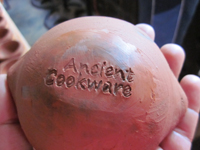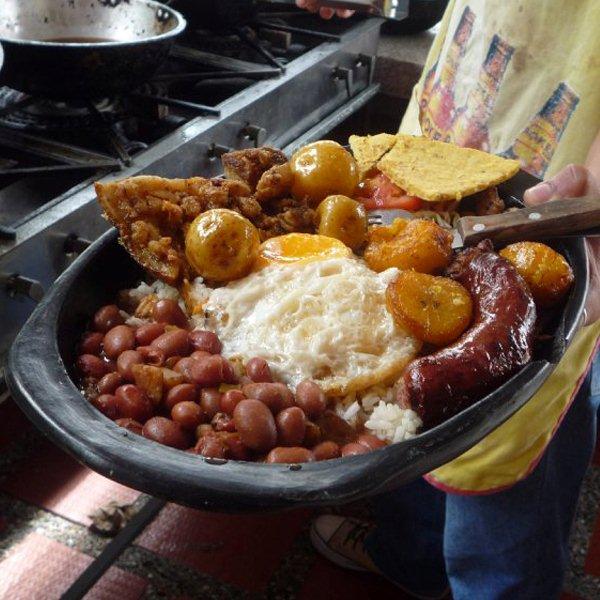Black Clay, La Chamba Rounded Soup Pot
Rating: 4.86/5
Related Products
Products


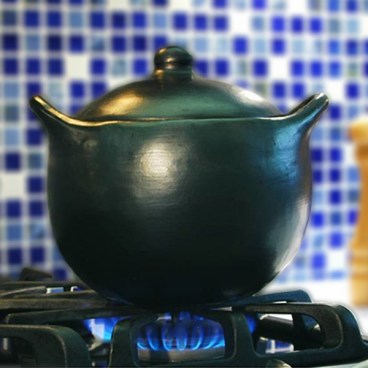
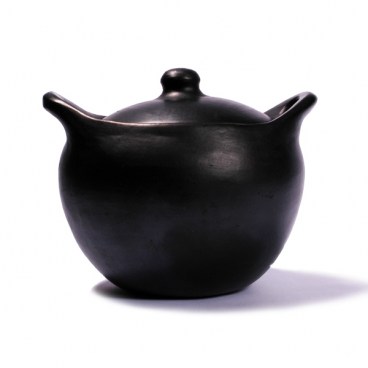
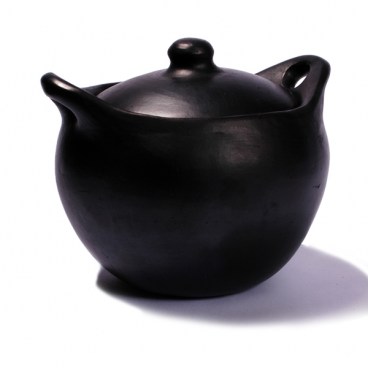
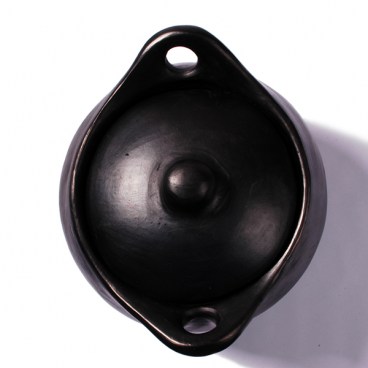
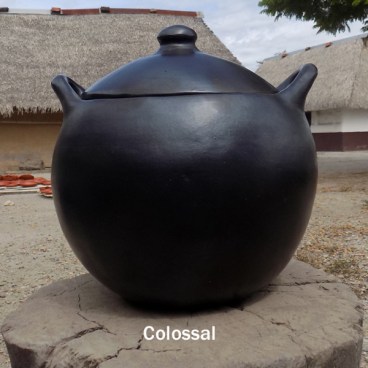
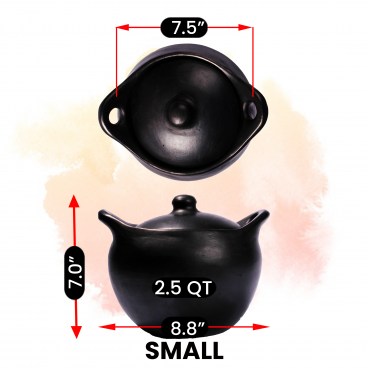
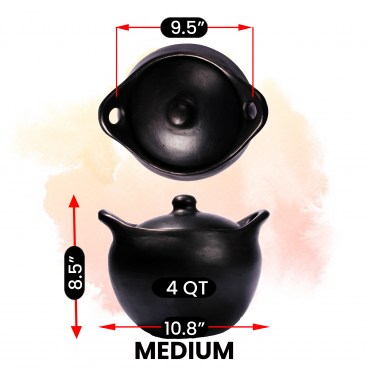
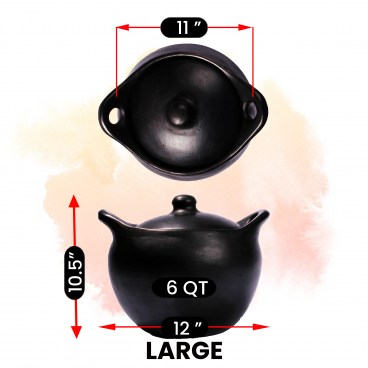
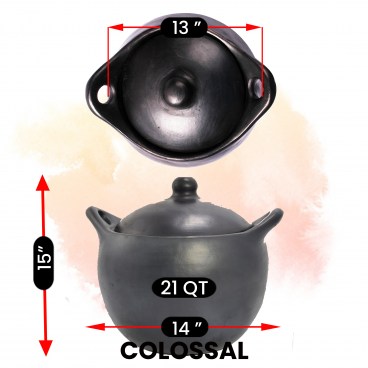
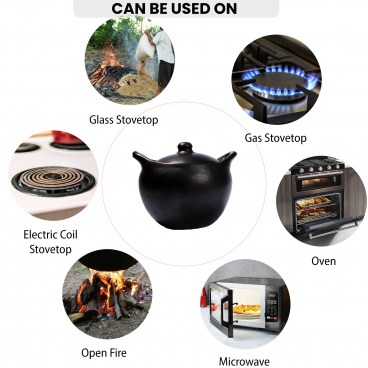
Description
About the piece
Care and Use
Curing
How they are Made
Recipes
Related Products
Reviews
Tuesday, 04 October 2016
I was reading the comments and felt some could be misunderstood. Never , when cooking on stove top, turn the heat up higher than mid range. (0-10, never higher than 5). Always gradual heat. When on stove top I place on 1 for a minute or so, then 2, gradual to 5. I don`t find it an issue. When used in oven; place in cold oven. Never set for `rapid heat`. I always select normal heating and never preheat. Also, olive oil is not a good choice for coating if you intend to use in oven. Olive oil does not due well in high heat settings. Use coconut oil or another choice I always soak my tops and bottoms in clean water, prior to use, fir 20 + mn. It helps steam. If food is not cooking properly then you are not cooking long enough. I never cook higher than 425, even though I have read 450 is acceptable. As for lingering odors, yes, that is going to happen due to this being made of a natural product and unglazed. I have three clay pots. One for breads, one for meats and one for veggies. I don`t mix for that reason but I also have no complaints. As with anything, research and practice.Groovykarma
Saturday, 10 September 2016
I purchased this item after watching videos of how it is hand-made, and I liked the organic purity and shape of it. I also own some cast-iron cookware. My understanding is that the clay cookware cannot be used "dry". It also cannot be exposed to sudden temperature changes, so I add the room temperature or cold water and start the soup. I sweat the onions and garlic in a cast iron skillet, not in the clay pot, according to the directions that came with it. I did not purchase a diffuser because I have a small cast iron skillet that it sits in while cooking over the (very low) gas flame. The skillet also works to catch any overspills. Doing it this way is the equivalent of a slow cooker, and the unglazed clay -- for some reason -- makes better tasting soups. I have no explanation for why suddenly I am loving the taste of my soups more than before. The 2.5 quarts is a bit large for one serving for a single person. I was able to boil spaghetti noodles in the pot (pushed the noodles down as they softened). I intend to purchase more La Chamba cookware ... glad I discovered it. The company, Ancient Cookware, super-packaged the pot in heavy-duty bubble-wrap, wadded packing paper and a thick cardboard box -- there was no way it could get broken in shipping. The lid fit perfectly, and if I want a tighter seal I can insert a silicone pad. I don`t use any soap to clean it - just some water and baking soda (or vinegar), and I can give it a good wipe-down with some coconut oil. I usually sanitize and keep down fungus or molds using hydrogen peroxide (H202) spray. To sum, this is a preferred material over cast iron for long cooking and cooking acidic foods, such as tomatoes, tomato sauces. The cast iron is good for sweating the onions and garlic, and meats for the soups or stews. Otherwise, the body cannot well assimilate the hard iron mineral that is leached from the cast iron during long or acidic cooking... the body needs a "bio-available" iron from dark leafy greens, etcetera.Gnosis
Wednesday, 31 August 2016
More reviews
Made from high quality clay… best in the world in terms of quality. Great for everyday use.jennifer bailey




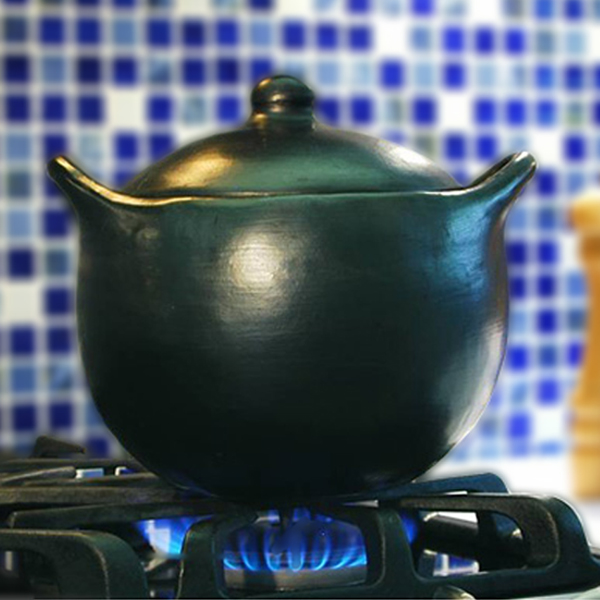
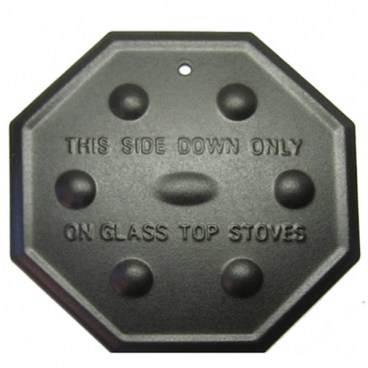

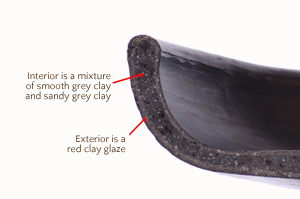 Three different types of clays from local mines are used in the making of these ceramics. They are dissolved in water and strained to remove little stones and other impurities. The interior of the ceramics are made with a mixture of a smooth, grey clay that gives the piece its strength and body, and a sandy grey clay that makes it easier to mold. The exterior is then “glazed” with a watery red clay which gives the piece a smooth surface, and allows for the polishing.
Three different types of clays from local mines are used in the making of these ceramics. They are dissolved in water and strained to remove little stones and other impurities. The interior of the ceramics are made with a mixture of a smooth, grey clay that gives the piece its strength and body, and a sandy grey clay that makes it easier to mold. The exterior is then “glazed” with a watery red clay which gives the piece a smooth surface, and allows for the polishing.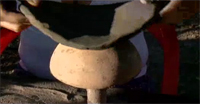 The process begins by flattening a ball of clay and forming it around a mold specifically made for each model. This “shell” is then smoothed and trimmed using tools fashioned from bamboo and plastic pieces.
The process begins by flattening a ball of clay and forming it around a mold specifically made for each model. This “shell” is then smoothed and trimmed using tools fashioned from bamboo and plastic pieces. 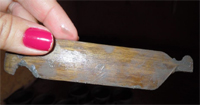 The pieces are then left to air dry, receiving a light polishing during the drying to make sure they have a smooth surface and free of sand. The pieces are then transported to other artisans that specialize in adding rims and/or handles. The handing off progression continues with other artisans which specialize in the production of the lids, which are custom
The pieces are then left to air dry, receiving a light polishing during the drying to make sure they have a smooth surface and free of sand. The pieces are then transported to other artisans that specialize in adding rims and/or handles. The handing off progression continues with other artisans which specialize in the production of the lids, which are custom 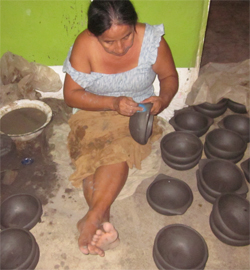 made for each piece. Even the knobs on the lids are made by artisans who specialize in only adding knobs to lids.
made for each piece. Even the knobs on the lids are made by artisans who specialize in only adding knobs to lids.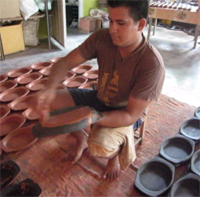 After each step the pieces are laid out to dry in the scorching La Chamba sun. Sometimes the process is delayed due to rains which prevent the drying of the pieces. When it begins to rain, the entire community is mobilized to quickly cover drying pieces that were outside in various production stages. The pieces are then lightly polished with a soft sponge to ensure a smooth exterior, and they are then taken to artisans that glaze each piece with the watery red clay. The glaze is not let to dry completely to allow for the next step of polishing, which is probably the most laborious part of the process, the polishing.
After each step the pieces are laid out to dry in the scorching La Chamba sun. Sometimes the process is delayed due to rains which prevent the drying of the pieces. When it begins to rain, the entire community is mobilized to quickly cover drying pieces that were outside in various production stages. The pieces are then lightly polished with a soft sponge to ensure a smooth exterior, and they are then taken to artisans that glaze each piece with the watery red clay. The glaze is not let to dry completely to allow for the next step of polishing, which is probably the most laborious part of the process, the polishing.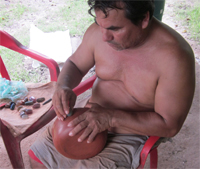 The hand polish, a process known as burnishing, is done by rubbing the entire piece with semiprecious stones until it has a uniform brightness on the surface. Depending on the size of a piece, the polishing can take up to half an hour to an hour. Originally, this polishing was done with smooth river rocks
The hand polish, a process known as burnishing, is done by rubbing the entire piece with semiprecious stones until it has a uniform brightness on the surface. Depending on the size of a piece, the polishing can take up to half an hour to an hour. Originally, this polishing was done with smooth river rocks 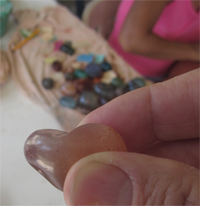 from the bottom of the Magdalena River, but is now done with agate stones brought from Brazil which are stronger. With use, the stones grind down even creating grooves from corners and edges.
from the bottom of the Magdalena River, but is now done with agate stones brought from Brazil which are stronger. With use, the stones grind down even creating grooves from corners and edges.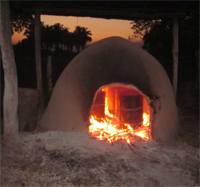 To start the firing process, the pieces are placed inside metal drums, with smaller objects first going inside larger earthenware pieces. These metal drums are then placed in wood burning ovens, usually late in the day so as to minimize the heat to the workers. The firing process takes approximately three hours, with the furnace reaching approximately 750°C. This high heat, together with the glazing and burnishing process, result in utilitarian pieces strong enough to withstand rough treatments and make them ovenproof.
To start the firing process, the pieces are placed inside metal drums, with smaller objects first going inside larger earthenware pieces. These metal drums are then placed in wood burning ovens, usually late in the day so as to minimize the heat to the workers. The firing process takes approximately three hours, with the furnace reaching approximately 750°C. This high heat, together with the glazing and burnishing process, result in utilitarian pieces strong enough to withstand rough treatments and make them ovenproof.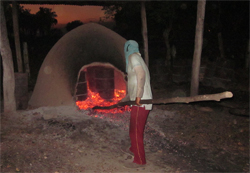 After the firing comes probably the most interesting part of the entire process and is what gives the pieces their unique black color. The metal drums are pulled out of the ovens with the help of long sticks.
After the firing comes probably the most interesting part of the entire process and is what gives the pieces their unique black color. The metal drums are pulled out of the ovens with the help of long sticks.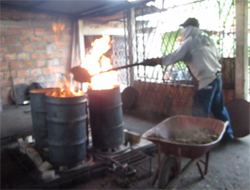 The drums are then covered to extinguish the flames but keep the material smoking vigorously for quite some time. The smoke penetrates the pieces giving each piece the black color that so characterizes products from La Chamba.
The drums are then covered to extinguish the flames but keep the material smoking vigorously for quite some time. The smoke penetrates the pieces giving each piece the black color that so characterizes products from La Chamba.